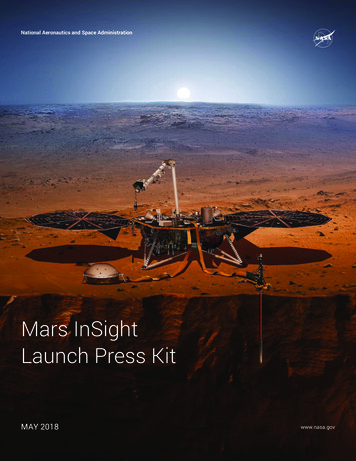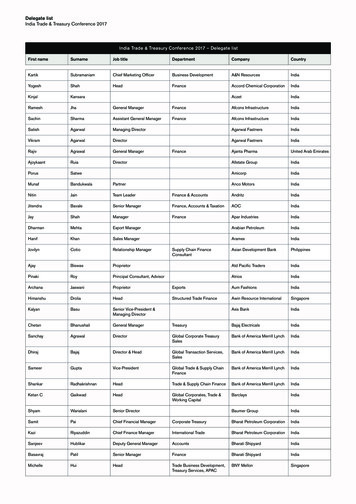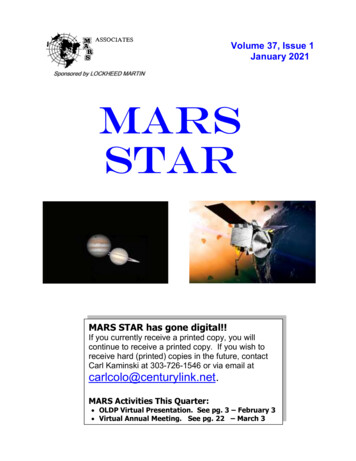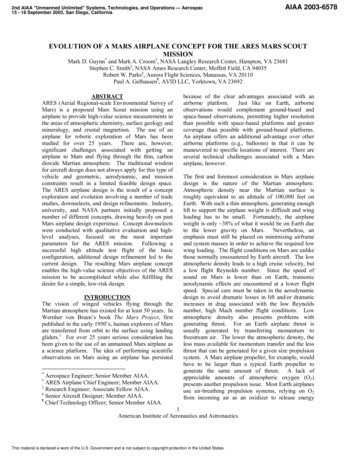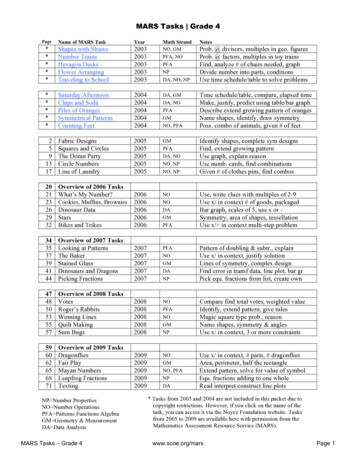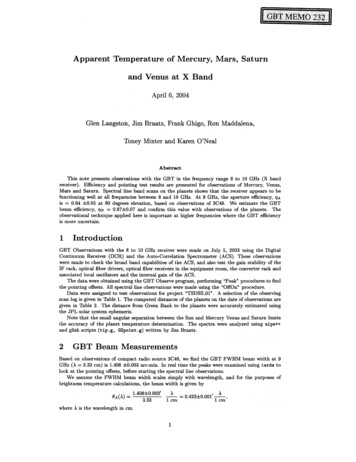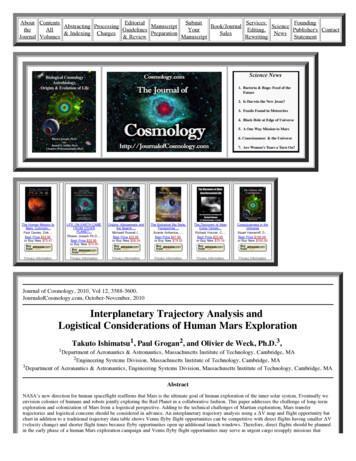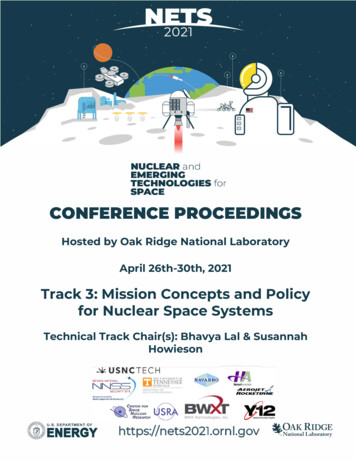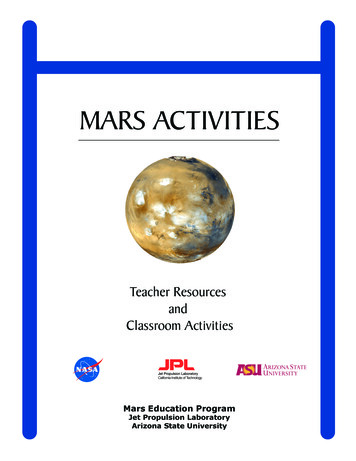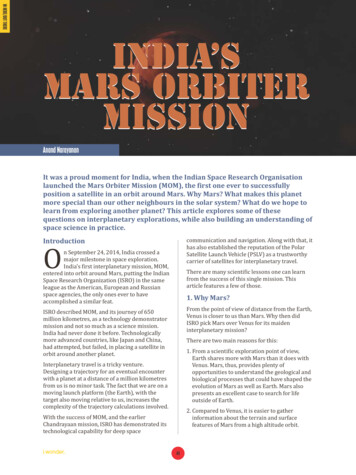
Transcription
IN HERE/OUT THEREINDIA’SMARS ORBITERMISSIONAnand NarayananIt was a proud moment for India, when the Indian Space Research Organisationlaunched the Mars Orbiter Mission (MOM), the first one ever to successfullyposition a satellite in an orbit around Mars. Why Mars? What makes this planetmore special than our other neighbours in the solar system? What do we hope tolearn from exploring another planet? This article explores some of thesequestions on interplanetary explorations, while also building an understanding ofspace science in practice.communication and navigation. Along with that, ithas also established the reputation of the PolarSatellite Launch Vehicle (PSLV) as a trustworthycarrier of satellites for interplanetary travel.IntroductionOn September 24, 2014, India crossed amajor milestone in space exploration.India’s first interplanetary mission, MOM,entered into orbit around Mars, putting the IndianSpace Research Organization (ISRO) in the sameleague as the American, European and Russianspace agencies, the only ones ever to haveaccomplished a similar feat.There are many scientific lessons one can learnfrom the success of this single mission. Thisarticle features a few of those.1. Why Mars?From the point of view of distance from the Earth,Venus is closer to us than Mars. Why then didISRO pick Mars over Venus for its maideninterplanetary mission?ISRO described MOM, and its journey of 650million kilometres, as a technology demonstratormission and not so much as a science mission.India had never done it before. Technologicallymore advanced countries, like Japan and China,had attempted, but failed, in placing a satellite inorbit around another planet.There are two main reasons for this:1. From a scientific exploration point of view,Earth shares more with Mars than it does withVenus. Mars, thus, provides plenty ofopportunities to understand the geological andbiological processes that could have shaped theevolution of Mars as well as Earth. Mars alsopresents an excellent case to search for lifeoutside of Earth.Interplanetary travel is a tricky venture.Designing a trajectory for an eventual encounterwith a planet at a distance of a million kilometresfrom us is no minor task. The fact that we are on amoving launch platform (the Earth), with thetarget also moving relative to us, increases thecomplexity of the trajectory calculations involved.2. Compared to Venus, it is easier to gatherinformation about the terrain and surfacefeatures of Mars from a high altitude orbit.With the success of MOM, and the earlierChandrayaan mission, ISRO has demonstrated itstechnological capability for deep space44
nearly one-third of the Martian surface could verywell have been covered with oceans.1.1 An Earth sibling of the pastThe most compelling reason for investigatingMars is that in many ways in its past, Mars had aclose semblance to Earth. Also, Mars rotates oncearound its axis in approximately the same 24 hourduration as Earth. This means that the day andnight cycle on Mars is similar to Earth.The obvious question then is where did all thiswater go?There are no definitive answers, although thesmall size of the planet could be a major reasonfor Mars’s global transformation - from a warmand wet planet to the cold, dry environment thatwe see today.Like Earth, Mars also has seasons, because its spinaxis is tilted at an angle of 25 degrees. When it iswinter in one of the poles, ice forms and grows insize. During summer when there is more directsunlight for longer durations, this ice cap melts.The following image of Mars was taken by theHubble Space Telescope. It shows how ice caps onthe North Pole of Mars grow and recede withwinter and summer seasons.Mars, presently, has a very thin atmosphere,mostly composed of carbon dioxide (CO ) gas.The atmosphere is so thin that the pressure onthe surface of Mars is only about 1/1000th theatmospheric pressure at sea-level on Earth. Butthe circumstances may have been quite differentin the past.Mars currently has a dry surface, but there aremany pieces of geological evidence on this planetthat suggest that there was once liquid waterflowing over it. Satellite images show windingchannels at several locations on the planet. Thewinding channels look very much like dried upriver beds, lake deltas and gullies carved byflowing water. Geologists hypothesize that theclimatic conditions on Mars were, at some time inthe distant past, suitable for liquid water. In fact,It is most likely that Mars had a dense COatmosphere (a greenhouse gas) in the past, whichkept the temperatures on its surface high enoughfor water to exist in liquid form. Over time, thestrong impact of solar winds (the constant streamof charged particles from the Sun travelling atspeeds of several hundreds of kilometres in onesecond), must have slowly eroded the gases fromthe Martian atmosphere. Being a small planet,Mars had a very weak magnetic field, insufficient45REDISCOVERING SCHOOL SCIENCE
to shield the planet from the charged particles ofthe solar wind, in the way that the Earth’smagnetic field shields our own atmosphere.Furthermore, the low surface gravity of Marsmeant that it could not hold onto gases as theygradually drifted out into space.From ice to vapouravoiding liquidThe temperature at which ice turnsinto water is called the melting point ofwater, and the temperature at whichwater turns into vapour is called itsboiling point. Both these temperaturesof phase transition depend on theambient atmospheric pressure. Underlow pressure conditions, both themelting and the boiling point will getreduced. Pressure on the surface ofMars is less than 1% of theatmospheric pressure at sea level onEarth. Under these low pressureconditions, as the polar ice caps melt,both the CO and H O in ice are directlyconverted into their vapour form. Thisprocess is knownas sublimation.For a visual account of the atmospheric lossprocesses, watch the NASA Goddard videos athttps://www.youtube.com/watch?v ogcaSmofPo4andhttps://www.youtube.com/watch?v 0 iz5Nt0Qc8How is AtmosphereLoss measured?By measuring the ratio of abundance ofdeuterium to hydrogen (D/H),scientists are trying to estimate therate at which Mars is currently losingwhatever is remaining of itsatmosphere. Deuterium, being twice asheavy as hydrogen, will be lost at aslower rate compared to hydrogen. Bystarting from a realistic assumption ofthe initial D/H ratio in the Martianatmosphere and by measuring thecurrent value for this ratio, thepast rate of atmospheric loss canbe assessed.Although, a good fraction of the surface water onMars has evaporated, scientists speculate thatthere may still be substantial reservoirs of waterin liquid form several thousand meters below theMartian surface. Significant fractions of this waterare in the polar regions of the planet, beyondabout 60 degrees latitude north or south, as thenext figure shows.As the density of the atmosphere lowered, waterin liquid form would have directly been convertedinto vapour. The temperature at which waterturns from liquid to vapour phase, called itsboiling point, is pressure dependant, as shown inthe graph below. As the atmospheric pressure onMars dropped, its ambient temperatures werehigh enough to evaporate the water on its surface.All the water vapour produced in this waygradually escaped into outer space.Mars Water Map: This is a global map of theMartian soil showing lower limits on the watercontent. The estimates are derived from thehydrogen abundance measured by the neutronspectrometer component of the gamma rayspectrometer suite on NASA's Mars Odysseyspacecraft. The highest water-mass fractions,exceeding 30 percent to well over 60 percent, are inthe polar regions, beyond about 60 degrees latitudenorth or south. Credit: NASA46
Water is considered an essential ingredient forthe emergence and evolution of life as we know it,here on Earth. Hence, finding water or anyevidence for its presence on Mars, has remained amajor goal for all Mars missions.Venus has a very dense atmosphere. The pressurefrom the atmosphere on the surface of Venus isestimated to be about 90-100 times theatmospheric pressure on Earth at sea level.Several layers of dense clouds envelop thesurface, like a thick blanket. Instruments on boarda spacecraft orbiting the planet from a highaltitude will not be able to peer through thisopaque covering for a clear bird’s eye view. Thisseriously hampers the scientific possibilities of anorbiter mission.The atmosphere of Venus is also not favourablefor landers (spacecrafts that land on a planetsurface). The presence of large amounts of CO inVenus’s atmosphere has created a stronggreenhouse effect on the planet. The averagetemperature on Venus is 450 degree centigrade,making it the hottest planet in the solar system,hotter than even Mercury. In addition, there arealso strong winds that blow at speeds of 300kilometres per hour and more, which keeps theatmosphere highly turbulent. Under such hostileconditions, it is difficult for the equipment onboard the landers to function properly forany duration.Photograph taken by the Mars Global Surveyorrobotic spacecraft which is currently orbiting Mars.On the surface are numerous channels thatresemble flow channels on Earth. These markscould be a result of flow of water on Mars in thepast. Photo Credit: JPL, NASA.In comparison, Mars offers a clear viewthrough its wispy atmosphere all the way down toits surface.The launch windowThe timing of the launch is a crucial decisioncontrolled by several factors. An ideal launch dateis one that requires the least amount of propellant(i.e., rocket fuel) to insert the spacecraft into theplanned trajectory. Fuel adds to the weight of thewhole mission, and fuel is also expensive.The direction of launch is an important factorimpacting fuel costs. We may naively think thatthe most efficient way to get to outer space is tolaunch the rocket directly up from Earth. But astraight line trajectory is a very inefficient way ofspending energy.Photograph of Martian surface taken by a highresolution stereo camera onboard European SpaceAgency's Mars Express. Along with flow channelsfrom water that once flowed on the surface. Onecan also see some impact craters possiblyproduced by impact of asteroids with Mars. Credits:ESA/ DLR/ FU Berlin (G. Neukum).Through its entire journey, the maximum fuel in arocket is burned out at the very initial stageswhen the launch vehicle is trying to lift off andspeed up away from the Earth’s gravitational pull.A great deal of fuel can be conserved at this stagethrough certain choices.1.2 A bird’s eye-view of what is belowAnother reason that makes Mars a compellingtarget, compared to Venus, is the convenience ofcollecting information about the terrain andsurface features once the spacecraft settles intoan orbit around the planet.1. Earth goes around the Sun at a speed of100,000 kilometres per hour (about 30 km/s).If the launch vehicle can be accelerated in thesame direction as Earth’s revolution around the47REDISCOVERING SCHOOL SCIENCE
Other attractionson MarsGlobal Dust Storms: Satellite and telescopeobservations have shown that large-scaledust storms are a recurring feature on Mars.They develop in a matter of hours and cancover the entire planet in a matter of a fewdays. Once these dust storms form, becauseof the low surface gravity of the planet, ittakes several weeks for the dust to settle backon the ground. It is not clear, despite a verywispy atmosphere, why the storms becomeso large or why they last so long on Mars.Volcanic Mountains: Mars also has thedistinction of having the largest knownmountain in the solar system. Standing tallwith a summit altitude of 22 kilometres andwith a base girth of nearly 600 kilometres,Mount Olympus is three times bigger thanMount Everest, the tallest peak on Earth.Mount Olympus is also the tallest among alarge number of extinct volcanic mountainson Mars. In addition to these, Mars also has ashield volcano called Olympus Mons. Ratherthan violently throwing up molten ash andlava, shield volcanoes are created by moltenmaterial slowly flowing down their sides.Great Canyons: The largest canyon in thesolar system is on Mars. Called the MarinerValley (after the Mariner 9 spacecraft thatdiscovered this valley), this gigantic gorgethat runs across the equator of Mars is about4000 kilometres long, as long as thecontinent of Asia. This gorge shows manysigns of past flooding, including deepchannels carved by what could have beenwater that once gushed from abovethe chasm.Mars Mariner Valley &Mars Mariner Valley artist: The rift regionseen along the equator of Mars is the MarinerValley, the largest canyon in the solar system.The next image is an artist's impression of theMariner Valley. Credit: NASAMars Mount Olympus 1: Mount Olympus,the tallest peak in the solar system, is onMars. This photograph taken by one of theNASA satellites gives a close-up view of thisnow extinct volcanic mountain. Credit: NASA48
Sun, it will give the vehicle a big head start invelocity (just as while jumping off a movingvehicle, we continue to run for some distance inthe same direction with some speed).Each stage of the rocket burns out, separates andfalls off at different times during the rocket’sflight. The heat shield with the payload inside isthe last to separate from the fourth stage of thePSLV rocket. This separation typically happensabout 3 minutes into the flight, when the rockethas climbed to an altitude of 130 kilometres.2. Earth rotates from west to east on its axis. Atthe equator, Earth's surface is rotating at 1600kilometres per hour. From an equatoriallaunching station, if we launch the rockettowards the east, it will get anotherenhancement in velocity from Earth's rotation.Thus by launching in the same direction as theEarth’s spin and its revolution around the Sun, thelaunch vehicle can take maximum advantage ofthese while trying to raise its altitude.The launch vehicle and MOM payloadsEvery satellite or spacecraft requires a launchvehicle, to propel and position the spacecraft intothe desired orbit. The launch vehicles are usuallyunmanned rockets. The Mars Orbiter Mission waslaunched on the Polar Satellite Launch Vehicle(PSLV). PSLV has four stages to it with propellantsthat operate at different stages of the flight. Thesatellite is referred to as the payload. In PSLV, thepayload is attached to the fourth and the finalstage of the rocket (see photograph).The satellite is enclosed in a heat shield, aprotective layer of several materials split into twohalves that come together. The heat shield hasthermal and acoustic absorption layers paddedinside. As the rocket picks up momentum, theparts of the rocket that come into direct contactwith the Earth’s atmosphere get heated up toseveral thousands of degrees from friction withthe Earth’s atmosphere. The shield insulates thesatellite from this aerodynamic heating.Photograph of PSLV-C25, the rocket that carriedMars Orbiter Mission. The rocket has a height of 45m, a diameter of 3 meters and weighsapproximately 300 tonnes. The rocket can deliverpayloads of up to 1500 kg weight intogeosynchronous orbit. ISRO49REDISCOVERING SCHOOL SCIENCE
micro-organisms, called methanogens,produce methane as a result of theirmetabolism. A similar biotic origin formethane is possible on Mars, if itsupports microbial life.4. A Mars Colour Camera is a 2000 x 2000pixel array camera that can take highresolution images of the Martian surfaceat the same energies as normally visibleto the human eye. With the cameraimages, one will be able to see shapesand features on Mars down to a distancescale of 25 kilometres.Mars Orbiter Mission Spacecraft (covered in goldfoil) attached to the 4th stage of PSLV-C25 andready for heat shield closure. ISROThe Mars Orbiter Mission has five scientificinstruments on-board. These five instrumentscover three broad science themes all linked toforge a better understanding of the climate andgeology of Mars. The payload instruments andtheir science objectives are as shown in the table.5. The Thermal Infrared ImagingSpectrometer’s purpose is to map theminerals on Martian surface. It does thisby capturing thermal radiation (i.e.,heat) emitted by the Martian surfaceheated by sunlight. The infrared lightentering the spectrometer is separatedinto tiny portions of photon energies andan image is captured at each ofthose energies.1. The Lyman Alpha Photometer, referredto shortly as LAP, has a detector that cansense ultraviolet photons. Theinstrument has the capability to measurethe current deuterium to hydrogenabundance ratio in the Martianatmosphere. This measurement willprovide an estimate of how fast Mars islosing its atmosphere.ConclusionMars exploration is an on-going saga. Even as youread this, a cluster of orbiters and robotic roversare surveying Mars, providing detailedinformation on Mars’s atmosphere, its climate,topography and soil composition, all the whilecontinuing to search for the presence of waterand microbial life. Since September 2014, MOMhas joined this collective effort.2. The Martian Exospheric NeutralComposition Analyzer, also calledMENCA, is a mass spectrometerequipment that can measure the massesof different molecules in the Martianatmosphere and also analyze theatmosphere’s chemical composition.Of all the planets and minor bodies of the solarsystem, Earth is the only one that is presentlyknown to harbour life. The process of how ourplanet evolved into such a safe haven for life is notyet fully understood. An answer to this is likely tocome from probing planets like Mars that wereonce habitable worlds, but have gradually evolvedaway from it.3. A Methane Sensor for Mars is aninstrument to search for the presence ofmethane molecules in the Martianatmosphere down to concentrationlevels as low as one part in a billionmolecules. Finding methane on Marscould signal the existence of microbiallife. A significant fraction of methane onEarth is of biological origin. CertainTo read a great deal more on Mars, visit:http://mars.nasa.gov/allaboutmars/50
(b) Orbiters: are space-crafts that enter intoan orbit around planets or moons ofplanets. Many of the later year Marsmissions like Mars Global Surveyor, MarsOdyssey, MAVEN all fall in the category oforbiters. ISRO’s Chandrayaan and MarsOrbiter Mission belong to this class.Types ofinterplanetary missionsInterplanetary space-crafts come withinone or more of the following threecategories: (a) Flyby space-crafts (b)Orbiters (c) Landers(c) Landers: are space-crafts which aredesigned to land on the surface of aplanet. Landers are often equipped withcameras to take surface levelphotographs of the terrain. They alsohave instruments to carry out in-situexperiments by extracting samples of soilor rock from the surface of the planet. Anextension of a lander is a rover, a roboticspacecraft designed to move around andsurvey a larger area of the planet.Landers are typically deployed from anorbiter. Classic examples are the twinrovers Spirit and Opportunity.(a) Flyby space-crafts: are missions thatfollow an escape trajectory, never to becaptured into any planetary orbit. Theonly opportunity to gather data iswhen they fly past the objects ofinterest. Their advantage is that thesame spacecraft can be used to acquireinformation on more than one object(planets, moons, asteroids etc) as longas the spacecraft’s trajectory brings itclose to the object. The earlyinterplanetary missions were primarilyflybys. Voyager 1, 2; Mariner 1 – 10;Pioneer 10 & 11 are all examples.1960 – 1970History of Mars explorationHuman explorations of Mars started way back inthe 1960s. In the ten years between 1960 and1970, there were 12 attempts from the thenSoviet Russia and the United States of America.After successive failures, on November 1964, theUS spacecraft Mariner 4 became the firstspacecraft to successfully flyby Mars.Since then, these explorations have been a mix oftriumphs and let-downs. The following tablesoffer a timeline summary of the history of Marsexplorations. (Data courtesy: Kiran Mohan, LiquidPropulsion Systems Centre, ISRO)51REDISCOVERING SCHOOL SCIENCE
1970 – 19802000 – 20102010 – Till Now1980 – 1990Further reading1. n - For details on the orbiter mission, thelaunch vehicle, ground segment operation, andplenty of images from the preparatory stages of themission.2. http://mars.nasa.gov/ - for details on the planet andthe history of Mars exploration by NASA.1990 – 20003. http://www.marsquestonline.org/ - for a variety ofmultimedia based learning activities on Marssuitable for school students.4. http://phoenix.lpl.arizona.edu/mars101.php - theNASA Phoenix mission site has a detailed write-up onthe search for water on Mars and the possibility offinding life.5. http://www.jpl.nasa.gov/news/news.php?release 2012-305 - on Curiosity finding evidencewater on Mars, finding ancient streambed gravelsAnand Narayanan teaches astrophysics at theIndian Institute of Space Science & Technology.His research is on understanding how baryonicmatter is distributed outside of galaxies at largescales. He regularly contributes to astronomy educationaland public outreach activities. Everyso often he likes totravel exploring the cultural history of South India.52
Venus is closer to us than Mars. Why then did ISRO pick Mars over Venus for its maiden interplanetary mission? There are two main reasons for this: 1. From a scientific exploration point of view, Earth shares more with Mars than it does with Venus. Mars, thus, provides
